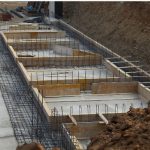Properties Of Aggregates
Approximately 75% of the volume of concrete is occupied by aggregates, so quality of aggregates plays an important role in determining properties of concrete. Aggregates are chemically inert, solid bodies held together by the cement. Aggregates come in various shapes, sizes, and materials ranging from fine particles of sand to large, coarse rocks. Natural aggregates are formed by process of weathering and abrasion or by artificially crushing large parent mass.
Because cement is the most expensive ingredient in making concrete, it is desirable to minimize the amount of cement used. 70 to 80% of the volume of concrete is aggregate in order to keep the cost of the concrete low. The selection of an aggregate is determined, in part, by the desired characteristics of the concrete. For example, the density of concrete is determined by the density of the aggregate. Soft, porous aggregates can result in weak concrete with low wear resistance, while using hard aggregates can make strong concrete with a high resistance to abrasion. Aggregates are of two basic types:
· Coarse: crushed rock, gravel or screenings.
· Fine: fine and coarse sands and crusher fines
Aggregates should be clean, hard, and strong. The aggregate is usually washed to remove any dust, silt, clay, organic matter, or other impurities that would interfere with the bonding reaction with the cement paste. It is then separated into various sizes by passing the material through a series of screens with different size openings. The final properties of the concrete will depend on the cement characteristics, the type and amount of aggregate, the water-cement ratio, and the completeness of the reaction subject to time, humidity, and temperature.
Examples of classes of concrete aggregate are shown below.
TYPES OF AGGREGATES

The choice of aggregate is determined by the proposed use of the concrete. Normally sand, gravel, and crushed stone are used as aggregates to make concrete. The aggregate should be well-graded to improve packing efficiency and minimize the amount of cement paste needed. Also, this makes the concrete more workable. Some of the important properties of aggregates are discussed below.
Properties of aggregates
The property of aggregates are mentioned below.
1. SOUNDNESS
Rocks that undergo volume changes due to wetting and drying are rare. However, aggregate is susceptible to volume change during freezing and thawing cycles. Freezing can cause internal stresses to build up as water inside the aggregate freezes and expands. A critical size can be calculated below which freeze-thaw stress is not a problem; however, for most rock it is greater than normal sizes.
2. WEAR RESISTANCE
A good aggregate will be hard, dense, strong, and free of porous material. The abrasion resistance of aggregate can be tested by the Los Angeles abrasion test; however, this test does not match well with concrete wear in the field.
3. ALKALI-AGGREGATE REACTION
An expansive reaction between some reactive forms of silica with the aggregate and alkalis in the cement paste. The result is overall cracking in the structure, manifesting itself in map or pattern cracking at the surface. This reaction can be controlled most easily by using low-alkali cements. However, due to changes in manufacturing, low-alkali cements may not be feasible. A better approach is to avoid aggregate with the potential or proven record of reactivity. A low w/c ratio is very impermeable and will slow down the reaction but not stop it. No adverse reactions will occur without external water.
4. OTHER ALKALI-SILICA REACTIONS
Sand-gravels found in river systems of Kansas and Nebraska are highly reactive and cause map cracking. Replacement of 30% of the aggregate with crushed limestone is effective in reducing the damage. Basically, it results in the separation of flat clay minerals causing very slow expansion.
5. ALKALI-CARBONATE REACTIONS
An expansive reaction involving clayey carbonate rock. Reaction can be controlled by using low-alkali cements or blending aggregate with other less reactive material. ASTM has set standards for deleterious substances in aggregates, which depend on application. This can be divided into two categories:
6. IMPURITIES
Solid materials – particles passing a 200-mesh sieve. These fine particles may increase water requirements and interfere with surface bonding between cement and coarse aggregates.
Soluble substances – organic matter may interfere chemically with alkaline cement pastes affecting setting time. Aggregates obtained from the sea should be thoroughly cleaned to avoid problems from salt contamination.
7. UNSOUND PARTICLES
Soft particles such as clay lumps, wood, and coal will cause pitting and scaling at the surface. Organic compounds can be released which interfere with setting and hardening. Weak material of low density which have low wear resistance should also be avoided.


